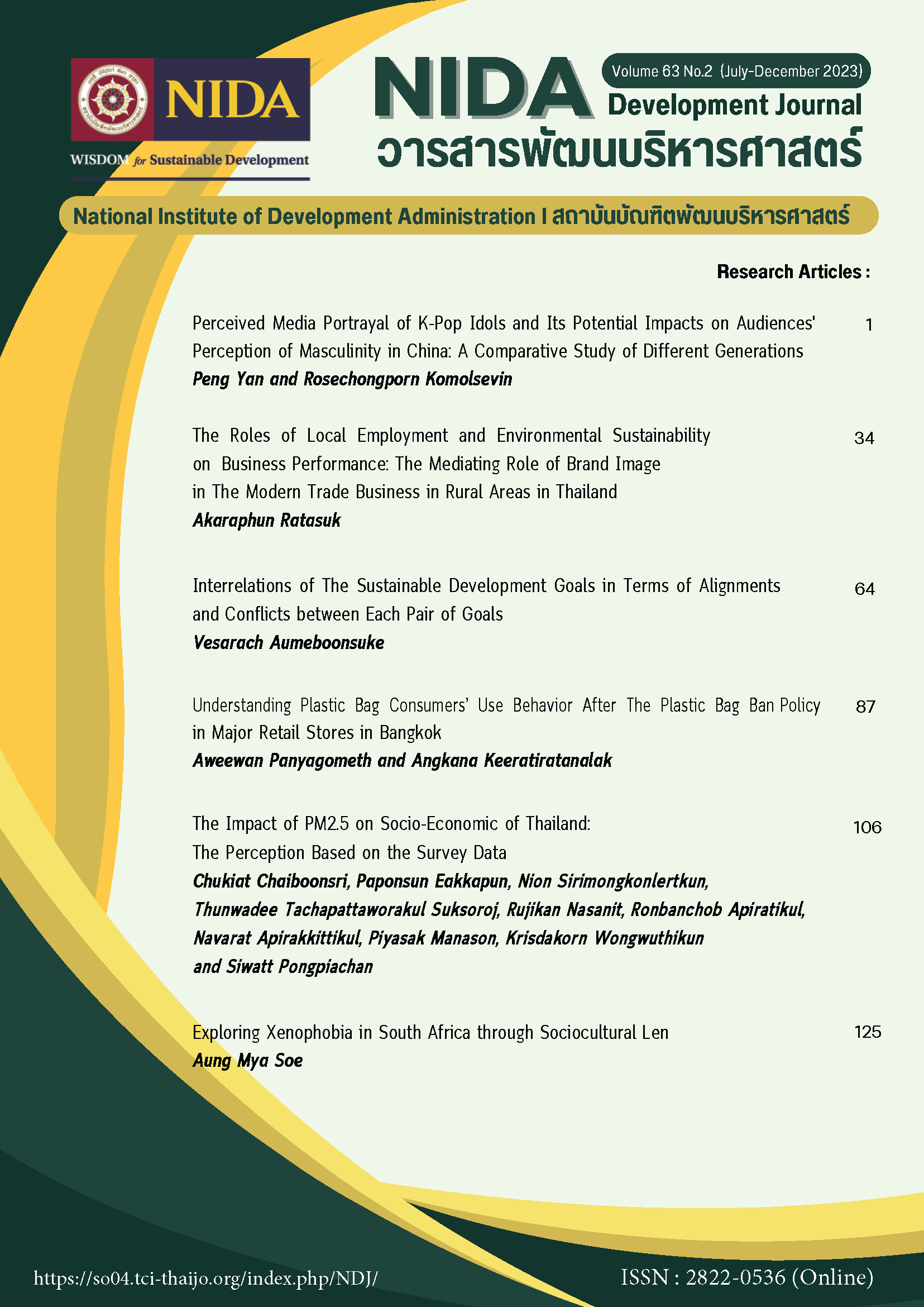Interrelations of The Sustainable Development Goals in terms of Alignments and Vonflicts between Each Pair of Goals
DOI:
https://doi.org/10.14456/ndj.2023.3Keywords:
Sustainable Development Goals, Economic Growth, Spearman Rank Correlation AnalysisAbstract
The purpose of this research was to investigate the Sustainable Development Goals (SDGs) by analyzing the interrelations and the possible conflicts among each pair of goals. Since there are 17 Sustainable development Goals (SDG1 - SDG17) in different aspects such as economics, subjective well-being, environmental concern, some pairs of goals might be complementing while some goals might be achieved at the expense of other goals. The results that were obtained based on the data during the COVID 19 pandemic (2020-2021). Data of all goals during the year 2020-2021 from countries in European region were collected from the Sustainable Development database. The nonparametric Spearman's rank correlation (ρ) analysis was employed to examine the monotonic associations between all possible combinations of the unique goal data pairs. The evidence from this study was beneficial for policy makers to form optimal strategies aimed to achieve the overall SDGs or to be aware of any possible conflicts among goals and develop some mechanisms to reconcile these existing conflicts. In addition, it also revealed the dynamic of interrelations and conflicts among SDGs during the crisis interval compared to the long-term span.
References
Ahmed, Z., Cary, M., Ali, S., Murshed, M., Ullah, H., & Mahmood, H. (2021). Moving toward a green revolution in Japan: symmetric and asymmetric relationships among clean energy technology development investments, economic growth, and CO2 emissions. Energy & Environment, 0958305X211041780.
Andriani, K. F., Mucelini, J., & Da Silva, J. L. (2020). Methane dehydrogenation on 3d 13-atom transition-metal clusters: A density functional theory investigation combined with Spearman rank correlation analysis. Fuel, 275, 117790.
Bilan, Y., Rubanov, P., Vasylieva, T. A., & Lyeonov, S. (2019). The influence of industry 4.0 on financial services: Determinants of alternative finance development. Polish Journal of Management Studies.
Bossel, H. (1999). Indicators for sustainable development: theory, method, applications (p. 138). Winnipeg: International Institute for Sustainable Development.
Gogu, E., RADU, C., Deaconu, A., Frasineanu, C., Triculescu, M., MIŞU, S., & Toma, S. (2021). Assessing The Impact of Clean Energy On Sustainable Economic Growth In European Union Member States. Economic Computation & Economic Cybernetics Studies & Research, 55(4).
Hauke, J., & Kossowski, T. (2011). Comparison of values of Pearson's and Spearman's correlation coefficients on the same sets of data. Quaestiones geographicae, 30(2), 87.
ICSU. (2017). SDG Interactions Report. https://sdg.iisd.org/news/icsu-presents-research-on-sdg-interactions/
ICSU, & ISSC. (2015). Review of the sustainable development goals: The science perspective. Paris: International Council for Science (ICSU).
Ismagiloiva, E., Hughes, L., Rana, N., & Dwivedi, Y. (2019, June). Role of smart cities in creating sustainable cities and communities: a systematic literature review. In International Working Conference on Transfer and Diffusion of IT (pp. 311-324). Springer, Cham.
Larson, P. D., & Larson, N. M. (2019). The Hunger of Nations: an empirical study of inter-relationships among the Sustainable Development Goals (SDGs). J Sustain Dev, 12(6).
Le Blanc, D. (2015). Towards integration at last? The sustainable development goals as a network of targets. Sustainable Development, 23(3), 176-187.
Le Blanc, D., Freire, C., & Vierros, M. (2017). Mapping the linkages between oceans and other Sustainable Development Goals: a preliminary exploration.
McGuire, S. (2013). WHO, World Food Programme, and International Fund for Agricultural Development. 2012. The State of Food Insecurity in the World 2012. Economic growth is necessary but not sufficient to accelerate reduction of hunger and malnutrition. Rome, FAO. Advances in Nutrition, 4(1), 126-127.
Ngankam, B. T. (2019). Sustainable Development Goals Synergies/Trade-offs: Exploring Long-and Short-Run Impacts of Economic Growth, Income Inequality, Energy Consumption and Unemploy-ment on Carbon Dioxide Emissions in South Africa. Journal of Sustainable Development, 12(4), 40-52.
Nilsson, G., Allison, E., William, W., Dey, M., Halpern, S., & Mccauley, D. (2016). SDG interactions. Nilsson, Griggs.
OECD. Economic growth: the impact on poverty reduction, inequality, human development and jobs (oecd.org). https://www.oecd.org/derec/unitedkingdom/40700982.pdf
OECD. Chapter 9. Women and SDG 9 – Industry, Innovation and Infrastructure: Build resilient infrastructure, promote inclusive and sustainable industrialization and foster innovation | Gender and the Environment: Building Evidence and Policies to Achieve the SDGs | OECD iLibrary (oecd-ilibrary.org).
https://www.oecd-ilibrary.org/sites/f17f0895-en/index.html?itemId=/content/component/f17f0895-en
Pradhan, P., Costa, L., Rybski, D., Lucht, W., & Kropp, J. P. (2017). A systematic study of sustainable development goal (SDG) interactions. Earth's Future, 5(11), 1169-1179.
Sachs, J., Kroll, C., Lafortune, G., Fuller, G., & Woelm, F. (2021). Sustainable development report 2021. Cambridge University Press.
Spearman, C. (1904). Spearman’s rank correlation coefficient. Amer. J. Psychol, 15(72-101), 16.
UN-Water. (2016). Water and sanitation interlinkages across the 2030 agenda for sustainable development. UN Water: Geneva, Switzerland.
UNEP. (2015). Policy Coherence of the Sustainable Development Goals – A Natural Resources Perspective. A. I. R. P. Report. https://wedocs.unep.org/handle/20.500.11822/9720;jsessionid=65FD62CCDF11C44A95DFB64718AF5699
United Nations. (2015). Global Sustainable Development Report 2015. https://www.un.org/en/development/desa/publications/global-sustainable-development-report-2015-edition.html
United Nations. (2016). Global Sustainable Development Report 2016. https://www.un.org/development/desa/publications/global-sustainable-development-report-2016.html
United Nations. (2018). Goal-9.pdf (un.org).
https://www.un.org/sustainabledevelopment/wp-content/uploads/2018/09/Goal-9.pdf
Vladimirova, K., & Le Blanc, D. (2016). Exploring links between education and sustainable development goals through the lens of UN flagship reports. Sustainable Development, 24(4), 254-271.
Zhang, W. (2015). General correlation and partial correlation analysis in finding interactions: with Spearman rank correlation and proportion correlation as correlation measures. Network Biology, 5(4), 163.
Zhang, Y., Runting, R. K., Webb, E. L., Edwards, D. P., & Carrasco, L. R. (2021). Coordinated intensification to reconcile the ‘zero hunger’and ‘life on land’Sustainable Development Goals. Journal of Environmental Management, 284, 112032.
Downloads
Published
How to Cite
Issue
Section
License
Copyright (c) 2023 NIDA Development Journal

This work is licensed under a Creative Commons Attribution-NonCommercial-NoDerivatives 4.0 International License.





